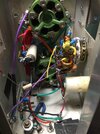Saturday: The Inductance to ground running parallel to the RF input from the 50:450 unun is what was missing. I do not understand why 750 ohms swamping resistance is the optimum value given the 50:450 ohm unun, but 750 is spot on. I used a 10T Pot in place of 750 ohm fixed and 750 shows a pronounced dip on the swr analyzer.
Deciding whether to follow Inductance values or the # of Toroid Turns for each band (10-11-20-40) was my primary issue. I went with uF values/readings but now it's clear I should follow the number of Turns instead as each of my 4 uH starting values were too low. Just a bit of rewinding and I should be set to re-assemble.
few more days until I can drive it but soon. Waiting for resistor delivery before I can try it.
neil, NYC
Deciding whether to follow Inductance values or the # of Toroid Turns for each band (10-11-20-40) was my primary issue. I went with uF values/readings but now it's clear I should follow the number of Turns instead as each of my 4 uH starting values were too low. Just a bit of rewinding and I should be set to re-assemble.
few more days until I can drive it but soon. Waiting for resistor delivery before I can try it.
neil, NYC
Last edited:

